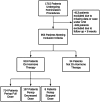Perioperative Estrogen Hormonal Therapy Does Not Increase Venous Thromboembolism Risk in Facial Feminization Surgery
- PMID: 38563527
- PMCID: PMC11584186
- DOI: 10.1097/PRS.0000000000011437
Perioperative Estrogen Hormonal Therapy Does Not Increase Venous Thromboembolism Risk in Facial Feminization Surgery
Abstract
Background: Conflicting data exist regarding increased perioperative venous thromboembolism (VTE) risk with feminizing hormone therapy. The effect has been poorly studied within the transgender population. Acute perioperative cessation of feminizing hormone therapy often leads to unpleasant side effects and exacerbates gender dysphoria in the perioperative period. The authors sought to identify VTE incidence in patients undergoing facial feminization surgery while continuing hormone replacement therapy throughout the time of surgery.
Methods: A 38-year retrospective cohort study within a 2-surgeon practice (D.K.O. and J.C.D.-B.) was designed to evaluate postoperative VTE in patients continuing hormone therapy. The primary outcome variable was postoperative VTE.
Results: A total of 1715 patients underwent facial feminization surgery within our search window. A total of 953 patients met final inclusion criteria. One patient (0.10%) was diagnosed with a VTE postoperatively, comparable to reported literature rates for similar cosmetic and orthognathic procedures. The average Caprini score of all patients was 3.1 ± 1.0 and the average case length was 491.9 ± 111.0 minutes. Subgroup analysis of patients before and after internal practice changes identified 714 patients (77.7%) continuing full-dose hormonal therapy perioperatively, 197 (20.7%) undergoing hormonal dose reduction to 25% to 50% perioperatively, and 8 who were either not taking hormonal therapy or stopped in the perioperative period. There was no significant difference in VTE incidence among the 3 subgroups ( P > 0.99).
Conclusions: Perioperative use of feminizing hormonal therapy does not increase risk for perioperative VTE in patients undergoing facial feminization surgery. Therefore, it is reasonable to continue these medications through the time of surgery.
Clinical question/level of evidence: Therapeutic, III.
Copyright © 2024 The Authors. Published by Wolters Kluwer Health, Inc. on behalf of the American Society of Plastic Surgeons.
Conflict of interest statement
The authors have no commercial associations or financial conflicts of interest to disclose. No funding was received for this article.
Figures
Similar articles
-
Effect of Cross-Sex Hormone Therapy on Venous Thromboembolism Risk in Male-to-Female Gender-Affirming Surgery.Ann Plast Surg. 2021 Jan;86(1):109-114. doi: 10.1097/SAP.0000000000002300. Ann Plast Surg. 2021. PMID: 32079810 Review.
-
No Thromboembolic Complications After Facial Feminization Surgery in Transgender Patients Utilizing Estrogen Therapy: A Retrospective Cohort Study.Transgend Health. 2023 Jul 28;8(4):344-351. doi: 10.1089/trgh.2021.0170. eCollection 2023 Aug. Transgend Health. 2023. PMID: 37525836 Free PMC article.
-
Risk for Venous Thromboembolism in Transgender Patients Undergoing Cross-Sex Hormone Treatment: A Systematic Review.J Sex Med. 2021 Jul;18(7):1280-1291. doi: 10.1016/j.jsxm.2021.04.006. Epub 2021 Jun 16. J Sex Med. 2021. PMID: 34140253
-
Estrogen Continuation and Venous Thromboembolism in Penile Inversion Vaginoplasty.J Sex Med. 2021 Jan;18(1):193-200. doi: 10.1016/j.jsxm.2020.10.018. Epub 2020 Nov 24. J Sex Med. 2021. PMID: 33243691
-
No Venous Thromboembolism Increase Among Transgender Female Patients Remaining on Estrogen for Gender-Affirming Surgery.J Clin Endocrinol Metab. 2021 Mar 25;106(4):e1586-e1590. doi: 10.1210/clinem/dgaa966. J Clin Endocrinol Metab. 2021. PMID: 33417686
Cited by
-
Transforming Culture: Postoperative Venous Thromboembolism Prophylaxis in a Transgender Patient on Estrogen.J Gen Intern Med. 2025 Jul 11. doi: 10.1007/s11606-025-09668-3. Online ahead of print. J Gen Intern Med. 2025. PMID: 40646333
References
-
- Herman JL, Flores AR, O’Neill KK. How Many Adults and Youth Identify as Transgender in the United States?. UCLA Williams Institute; 2022.
-
- Connors JM, Middeldorp S. Transgender patients and the role of the coagulation clinician. J Thromb Haemost. 2019;17:1790–1797. - PubMed
-
- Hembree WC, Cohen-Kettenis PT, Gooren L, et al. . Endocrine treatment of gender-dysphoric/gender-incongruent persons: an Endocrine Society clinical practice guideline. J Clin Endocrinol Metab. 2017;102:3869–3903. - PubMed
MeSH terms
Substances
LinkOut - more resources
Full Text Sources
Medical
Research Materials
Miscellaneous


